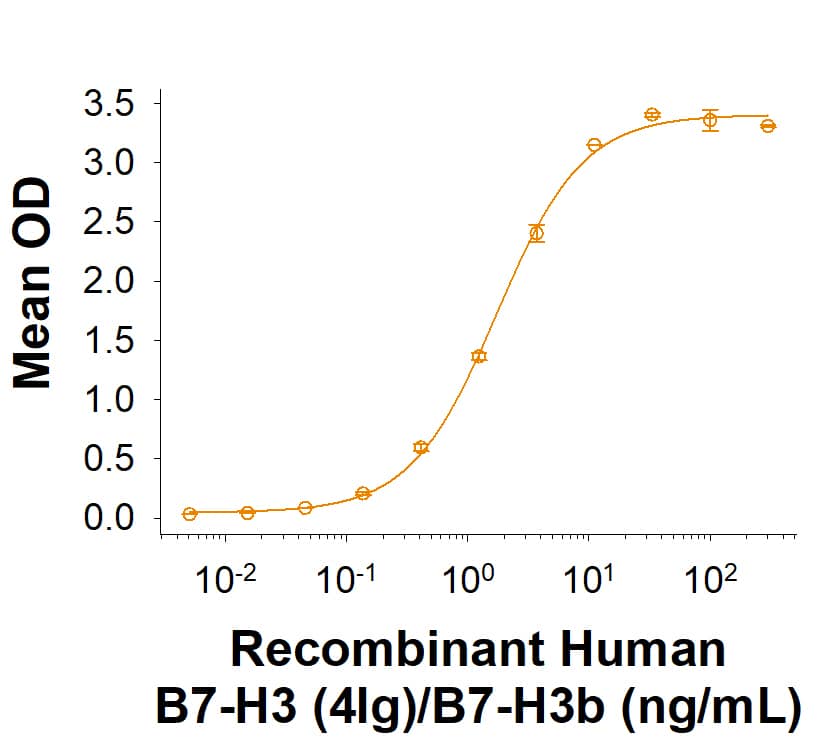Recombinant Human B7-H3 (4Ig)/B7-H3b Protein Best Seller
R&D Systems, part of Bio-Techne | Catalog # 2318-B3

Key Product Details
- R&D Systems NS0-derived Recombinant Human B7-H3 (4Ig)/B7-H3b Protein (2318-B3)
- Quality control testing to verify active proteins with lot specific assays by in-house scientists
- All R&D Systems proteins are covered with a 100% guarantee
Product Specifications
Source
Gly27-Thr461, with a C-terminal 10-His tag
Purity
Endotoxin Level
N-terminal Sequence Analysis
Predicted Molecular Mass
SDS-PAGE
Activity
Recombinant Human B7-H3 (4Ig)/B7-H3b (Catalog # 2318-B3) binds to Human B7-H3 Antibody (Catalog # MAB1027) with an ED50 of 0.600-6.00 ng/mL.
Reviewed Applications
Read 4 reviews rated 4 using 2318-B3 in the following applications:
Scientific Data Images for Recombinant Human B7-H3 (4Ig)/B7-H3b Protein
Recombinant Human B7‑H3 (4Ig)/B7-H3b Protein Binding Activity.
In a functional ELISA, Recombinant Human B7-H3 (4Ig)/B7-H3b (Catalog # 2318-B3) binds to Human B7-H3 Antibody (MAB1027) with an ED50 of 0.600-6.00 ng/mL.Formulation, Preparation and Storage
Carrier Free
What does CF mean?CF stands for Carrier Free (CF). We typically add Bovine Serum Albumin (BSA) as a carrier protein to our recombinant proteins. Adding a carrier protein enhances protein stability, increases shelf-life, and allows the recombinant protein to be stored at a more dilute concentration. The carrier free version does not contain BSA.
What formulation is right for me?In general, we advise purchasing the recombinant protein with BSA for use in cell or tissue culture, or as an ELISA standard. In contrast, the carrier free protein is recommended for applications, in which the presence of BSA could interfere.
Carrier: 2318-B3
| Formulation | Lyophilized from a 0.2 μm filtered solution in PBS with BSA as a carrier protein. |
| Reconstitution | Reconstitute at 100-200 μg/mL in sterile PBS. |
| Shipping | The product is shipped at ambient temperature. Upon receipt, store it immediately at the temperature recommended below. |
| Stability & Storage | Use a manual defrost freezer and avoid repeated freeze-thaw cycles.
|
Carrier Free: 2318-B3/CF
| Formulation | Lyophilized from a 0.2 μm filtered solution in PBS. |
| Reconstitution | Reconstitute at 100-200 μg/mL in sterile PBS. |
| Shipping | The product is shipped at ambient temperature. Upon receipt, store it immediately at the temperature recommended below. |
| Stability & Storage | Use a manual defrost freezer and avoid repeated freeze-thaw cycles.
|
Background: B7-H3
Human B7 homolog 3 (B7-H3) is a member of the B7 family of immune proteins that provide signals for the regulation of immune responses (1 - 3). Other family members include B7-1, B7-2, B7-H1/PD-L1, B7-H2, and PD-L2. B7 family proteins are type I transmembrane immunoglobulin (Ig) superfamily members that contain extracellular Ig V‑like and Ig C‑like domains with a short cytoplasmic tail. Among the family members there is about 20 - 40% amino acid (aa) sequence identity. B7-H3 was initially reported to be a 316 aa type I transmembrane precursor protein that contained a signal sequence, an extracellular region with one V‑type and one C‑type Ig domain, a transmembrane segment and a short cytoplasmic tail (1). Subsequent studies have identified a second 110 kDa form whose precursor is 534 aa in length. Termed 4IgB7-H3 or B7-H3b, this molecule has two additional Ig-like domains (one V‑type and one C‑type) and shows a ubiquituous expression pattern (4, 5). It would appear that the human 4Ig form is the principal, if not the only form of B7-H3 (5). Its precursor contains a 26 aa signal sequence, a 435 aa extracellular region, a 31 aa transmembrane domain, and a 42 aa cytoplasmic tail. The four Ig-like domains alternate between V‑type and C‑type, and apparently are the consequence of a V‑C type tandem duplication (4, 5). B7-H3b is expressed on dendritic cells as well as activated T, B and NK cells (5). The mouse gene differs from that of human in that it cannot code for four Ig-like domains; only a V‑type:C‑type pair (4). Human B7-H3b binding to an undefined receptor has shown to be inhibitory to NK cell illing and cytokine release (6). It also seems to be required for late stage osteoblast differentiation (7).
References
- Chapoval, A.I. et al. (2001) Nat. Immunol. 2:269.
- Sharpe, A.H. and G.J. Freeman (2002) Nat. Rev. Immunol. 2:116.
- Coyle, A. and J.Gutierrez-Ramos (2001) Nat. Immunol. 2:203.
- Sun, M. et al. (2002) J. Immunol. 168:6294.
- Steinberger, P. et al. (2004) J. Immunol. 172:2352.
- Prasad, D.V.R. et al. (2004) J. Immunol. 173:2500.
- Suh, W-K. et al. (2004) Proc. Natl. Acad. Sci. USA 101:12969.
Long Name
Alternate Names
Gene Symbol
UniProt
Additional B7-H3 Products
Product Documents for Recombinant Human B7-H3 (4Ig)/B7-H3b Protein
Product Specific Notices for Recombinant Human B7-H3 (4Ig)/B7-H3b Protein
For research use only
